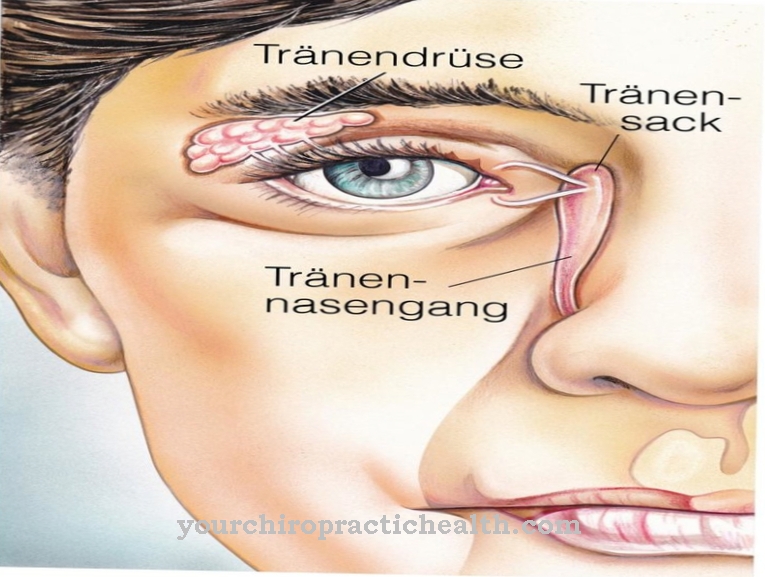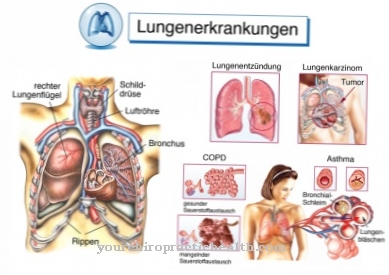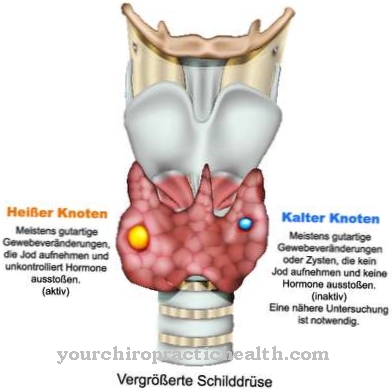At the ADULT syndrome it is a genetically caused disease that occurs on average only with a very low frequency. In principle, ADULT syndrome is passed on in an autosomal dominant manner. The name of the disease is an acronym that stands for A.cro-D.ermato-Ungual-L.acrimal-Tooth-syndrome stands.
What is ADULT Syndrome?

ADULT syndrome was first described by Propping in 1933. The long form of the disease name refers to the areas of the body where abnormalities or deformities occur in the context of ADULT syndrome. This primarily includes skin and nails as well as teeth and the lacrimal system. Typical of the disease is dysplasia of the toenails and fingernails, pronounced freckles, ectrodactyly and clogged lacrimal glands.
In addition, there is usually also hypodontia, with permanent teeth usually being lost at an early age. In principle, the ADULT syndrome is an extremely rare genetic disease. So far, the syndrome has only been known in two families and 14 individual cases. The ADULT syndrome is passed on via an autosomal dominant [hereditary disease inheritance]].
causes
ADULT syndrome is an extremely rare disease. The prevalence of ADULT syndrome is estimated at around 1: 1,000,000. ADULT syndrome is a hereditary disease, the causes of which can be found in genetic mutations. The disease is inherited as an autosomal dominant trait. The underlying gene mutation is found on the so-called TP63 gene.
The locus 3q28 is specifically affected. This locus is responsible for coding a specific protein, which is a factor in transcription. It plays an important role in the formation of the limbs and tissues of the nails and hair. Genetic mutations in this gene location usually result in corresponding malformations in the affected persons.
Symptoms, ailments & signs
In the context of ADULT syndrome, the sick people suffer from typical symptoms. Basically, ectrodactyly, dysplasia of the nails and blocked tear ducts are among the most important symptoms of the disease. In addition, patients usually show characteristic changes in the pigments on the skin, reminiscent of freckles. This symptom is also known as something called freckling.
Also in the area of the teeth usually anomalies occur in ADULT syndrome. Some teeth may be missing. In particularly severe cases, the person has no set of teeth. In addition, exfoliative dermatitis is also possible in patients with ADULT syndrome, which primarily affects the toes and fingers. The hair of people suffering from ADULT syndrome is mostly blond and thinning. Eyelashes and eyebrows are underdeveloped.
In principle, the ADULT syndrome is a so-called allelic disease. This means that only special genetic forms on the corresponding gene lead to the development of the ADULT syndrome. If other gene loci are affected by the mutations, other types of diseases usually develop.
For example, the Hay-Wells syndrome, the EEC syndrome, SHFM4 and the Rapp-Hodgkin syndrome are possible. Depending on the severity of the ADULT syndrome, the symptoms differ considerably in the sick patient. Thus, in addition to mild forms of the syndrome, there are also cases in which people have all sorts of symptoms.
For example, some of the affected patients show a cleft palate, cleft foot or cleft hand. Some people are highly photophobic and have chronic blepharitis. Symptoms such as blepharophimosis, conjunctivitis or dacryocystitis may also appear.
Diagnosis & course
Numerous medical examinations are usually necessary to make a reliable diagnosis of ADULT syndrome. In most cases, the diagnosis of the disease is relatively long. This is mainly due to the fact that ADULT syndrome is a very rare disease.
If newborn babies or toddlers show typical signs of the disease in the first few years of life, a doctor should be consulted. The first thing to notice are the external anomalies, for example in the face. The pediatrician refers the patient to a specialized doctor who makes the further diagnosis. At the beginning he takes an anamnesis with the parents of the child and the patient himself and collects clues about the symptoms.
The suspicion of a hereditary disease usually falls quickly. Various visual examinations of the patient limit the spectrum of possible diseases considerably. In addition, examination procedures such as X-ray techniques and other imaging methods are used. In this way, for example, the malformations of the dentition can be detected even in small children.
Complications
Various complications can arise in ADULT syndrome. These depend on the severity of the syndrome. In most cases, the patient has a relatively high number of freckles. These can be multiplied again in summer due to the increased UV radiation. The freckles themselves are not a complaint, however.
Often the tear ducts of those affected are closed. It is not possible to cry with this. This has not only psychological but also physical effects. Crying removes foreign objects from the eye. If this cannot be done, it often ends in inflammation of the eye. Most of those affected are missing teeth.
Only some or all of the teeth may be missing. This leads to teasing and bullying, especially in children, and can trigger severe depression and other psychological problems in the patient. Dermatitis is increased on the toes and fingers. However, this can be treated relatively well.
The ADULT syndrome itself cannot be treated or prevented as it is inherited. However, the symptoms associated with this syndrome can be treated. This increases the life expectancy of the patient and makes everyday life easier.
When should you go to the doctor?
Since ADULT syndrome is a genetic disease, it usually cannot be cured by a doctor. For this reason, only symptomatic treatment is possible, which should always be given if there is pain or severe restrictions in the patient's life. As a rule, ADULT syndrome leads to pigment disorders. These do not primarily represent a health risk and therefore do not necessarily have to be treated by a doctor.
Not infrequently, however, the pigment disorders lead to psychological complaints, which can be treated by a psychologist. Treatment must also be carried out because of the cleft palate. Since it is still not uncommon for a split foot to occur, this can also be corrected by an intervention. Medical treatment is also necessary if there are other skin complaints, for example due to increased UV radiation. As a rule, the respective specialist can always be consulted directly in order to receive immediate treatment.
Doctors & therapists in your area
Treatment & Therapy
A causal therapy for ADULT syndrome is currently not possible, as the relevant knowledge is lacking. Due to the rarity of ADULT syndrome, there is a lack of adequate research studies. Instead, patients are treated based on their symptoms. Orthodontic treatment is used, for example, to deal with malformations of the teeth. In addition, patients usually receive dentures early on.
Outlook & forecast
The ADULT syndrome extremely reduces the patient's quality of life and makes everyday life very difficult. The symptoms can be very different. In many cases, there are malformations of the nails and eyes. The skin is also affected by pigment disorders. These can lead to decreased self-esteem. Often there is also a cleft palate, which can be associated with speech disorders.
The feet are also affected by malformations, so that in some cases movement restrictions can occur. If necessary, the patient is dependent on the help of other people in everyday life in order to cope with everyday life.
It is not possible to treat ADULT syndrome so it can only limit symptoms. This is usually done through surgical interventions and various therapies. Most of the time, life expectancy is reduced due to ADULT syndrome.
With early treatment of the symptoms, everyday life in adulthood can be normalized. The development of motor skills and mental abilities is usually not influenced by the ADULT syndrome.
prevention
At the present time it is not yet possible to prevent the ADULT syndrome. On the one hand, the hereditary disease has not been adequately researched; on the other hand, there is generally a lack of experience with the prevention of genetic diseases and the corresponding mutations.
Aftercare
Since ADULT syndrome is a genetic disease, the options for follow-up care for this disease are relatively limited. The person concerned is therefore primarily dependent on the early diagnosis and treatment of the disease so that there are no further complaints or further complications. Since this is a genetic disease, genetic counseling can also be very useful to clarify to what extent the disease can be prevented from being passed on to the offspring.
This may prevent the recurrence of ADULT syndrome. In most cases, the treatment is performed by an orthopedic surgeon. In most cases, there are no particular complications, and the procedure itself depends on the exact malformations of the teeth and their severity.
The procedure should be carried out very early so that there are no problems with the development of the child. In many cases, those affected are dependent on psychological support from friends or their own family so that they do not get upset or become depressed. A psychologist can also be consulted in serious cases. The syndrome itself does not usually reduce the patient's life expectancy.
You can do that yourself
Since ADULT syndrome is a very rare disease, there have been few field reports to date to give a comprehensive overview of possible self-help. As far as possible, those affected should inform themselves about the disease, its course and complications. This helps to avoid finding yourself unprepared in unpleasant situations. If possible, information should be exchanged with other sick people. They can use helpful hints and tips. This strengthens your own self-confidence and reduces helplessness.
In everyday life it is particularly helpful when the sick person surrounds himself with people who give him stability and security. A good social network increases well-being and increases the joy of life. Social isolation can lead to depressive moods and other mental illnesses.
As soon as the person concerned experiences fears or panic attacks that affect their lives, it is advisable to seek help from a therapist in good time. Together with him, he can develop behavioral strategies that he can ultimately use independently in everyday life in order to be able to cope with his life more symptom-free.
Despite the illness, participation in social activities is possible. The person concerned should pursue these with self-confidence. With a stable self-esteem it will be possible for him to enjoy life despite all adversities.





.jpg)
.jpg)




















